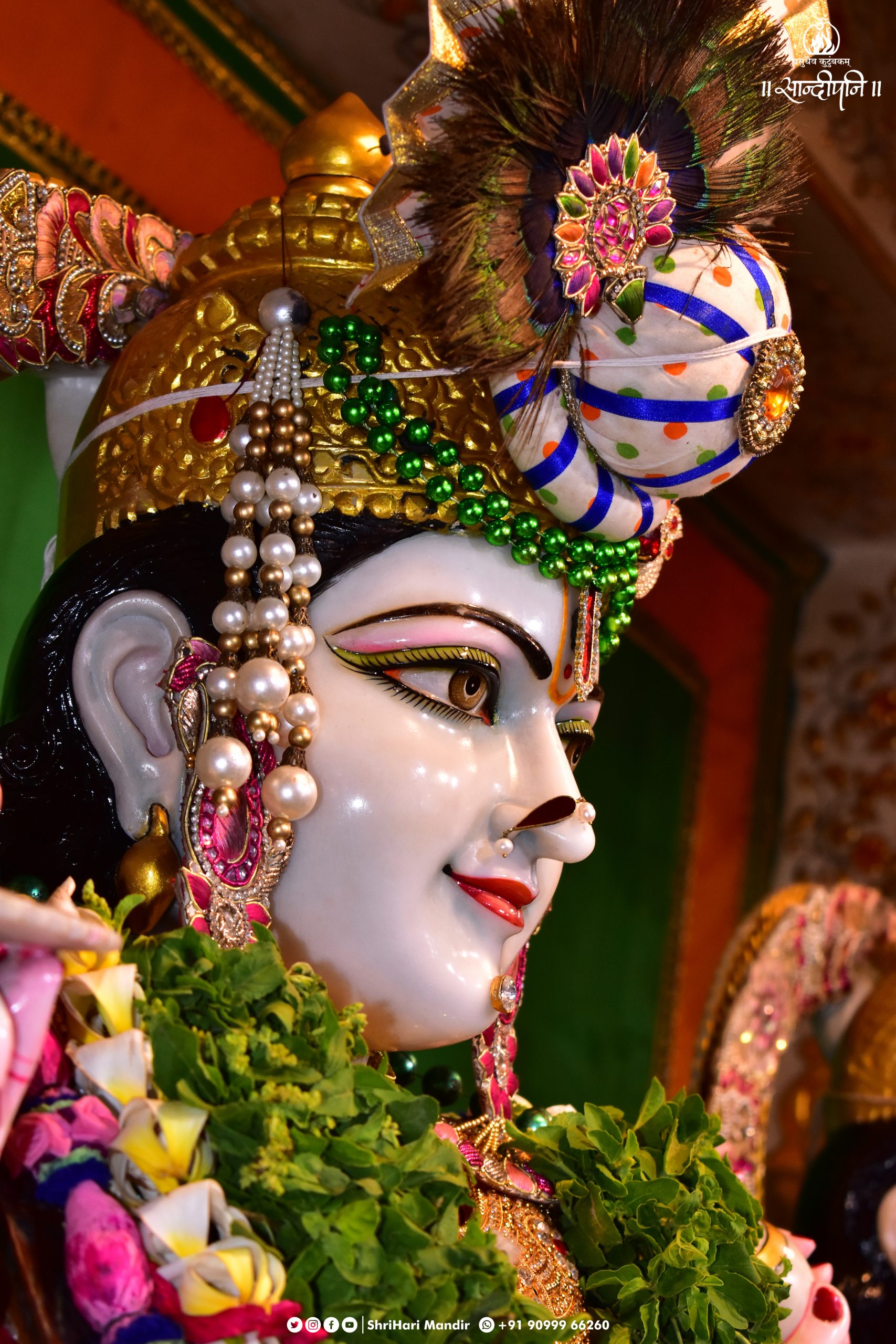Kamika Ekadashi Vrat Katha
🍃 A Katha to devour one’s Sins, and a Fast to reward one with merits!
⚫ ShriHari Mandir (Porbandar) is celebrating Kāmikā Ekādaśī fast on Wednesday, 4th August, 2021.
⚫ This fast is observed on the eleventh day of the second fortnight (Krṣṇa pakṣa) of the month of ‘Āṣāḍha’ in the Gujarat region, and of the month of ‘Śrāvaṇa’ in the Northern part of India.
⚫ The unique significance of each Ekādaśī Kathā is explained to Dharmarāja Śrī Yudhiṣṭhira Māharāja by Śrī Krṣṇa, in the ‘Uttara Khaṇḍa’ of the Padma Purāṇa.
⚫ Śrī Krṣṇa explains the significance of this Kāmikā Ekādaśī fast through a conversation between Brahmājī and Devarṣī Nārada—a tale to destroy all sins.
⚫ Upon merely remembering this Ekādaśī, one attains the fruit of performing a Vājapeya yajña (one of the important and obligatory Vedic sacrifices one must perform).
⚫ On this Ekādaśī:
- One must engage in the ritual worship of the Lord through His various names—Śridhara, ShriHari, Śri Viṣṇu, Śri Mādhava, Śri Madhusūdhana.

⚫ This Kāmikā Ekādaśī fast:
- Is most excellent to uplift the sinful who are drowning in the ocean of material existence;
- Is the destroyer of all evils;
- Reaps great fruits;
- Allows one to attain Heaven.
⚫ What are the fruits reaped from observing this Ekādaśī fast?
- One who engages in the ritual worship of Śrī Krṣṇa:
- Reaps fruit that is not easily obtainable even from visiting holy places such as the River Gaṅgā (Ganges), Mount Kāśī, Naimiṣāraṇya, or Puśkara.
- Attains the same fruit as one would, from bathing in the River Godāvari during Vyatipāta Yoga and Daṇḍa Yoga; which are two inauspicious time periods as per Sanātana Vedic Astrology (jyotiṣa śāstra).
- One who observes this Ekādaśī fast:
- And stays awake at night, never has a sight of the frightful Yamarāja (Lord of Death); nor does he ever experience any catastrophes.
- Reaps fruit akin to that of one who performs charity of:
- The entire earth—including the ocean and forests.
- Various commodities for a cow who has just given birth, and thus, become a Mother.
⚫ What is the significance of offering Holy Basil (Tulasī) leaves to Lord Viṣṇu on Ekādaśī?
- Lord Viṣṇu does not become as content with all other offerings (such as valuable ruby gemstones and pearls), as He does when He is offered Tulasī leaves.
- One who worships the Lord through Tulasī leaves, is rid of all sins from their present lifetime.
🍃 Tulasī Mahimā and Vandanā Śloka
या दृष्टा निखिलाघसंघशमनी स्पृष्टा वपुष्पावनी
रोगाणामभिवन्दिता निरसनी सिक्तान्तकत्रासिनी ।
प्रत्यासत्तिविधायिनी भगवतः कृष्णस्य संरोपिता
न्यस्ता तच्चरणे विमुक्तिफलदा तस्यै तुलस्यै नमः।।
yā dṛṣṭā nikhilāghasaṃghaśamanī spṛṣṭā vapuṣpāvanī
rogāṇāmabhivanditā nirasanī siktāntakatrāsinī ।
pratyāsattividhāyinī bhagavataḥ kṛṣṇasya saṃropitā
nyastā taccaraṇe vimuktiphaladā tasyai tulasyai namaḥ।।
‘We bow down again and again to Goddess Tulasī, whose sight destroys our sins; whose touch purifies our body; to whom by paying obeisance, we are cured of our illnesses; who, when watered, frightens even the Yamarāja (Lord of Death); who, upon being strung into a mala and adorned around Śrī Krṣṇa’s neck; as well as being mounted on His head, takes us closer to Him; and, who by offering to His Lotus Feet, grants us the fruit of liberation.’

⚫ What is the significance of lighting and performing charity of a ghee-lamp (dīpa diyā) on the day of Ekādaśī?
- One who lights a lamp of ghee or sesame oil in front of the Lord, is worshipped by millions of lamps and resides in Heaven, after leaving one’s body.
- For one whose ghee lamp is constantly illuminated facing Lord Krṣṇa, his ancestors are situated in Heaven, drinking nectar.
- One who performs charity of ghee lamps (dīpa dāna) throughout the day of Ekādaśī earns merits whose count even Dharmarāja Citragupta knows not!
⚫ One who faithfully listens to the significance of this Ekādaśī vrat, is freed of all their sins and resides in Lord Viṣṇu’s world.
🌐 Stay tuned to know more about the respective significance of, rituals involved in, and fruits reaped from, each Ekādaśī Kathā!
🔆 #Did-You-Know—One who performs ritual worship of Lord Viṣṇu during the month of Śrāvaṇa, worships all categories of deities. Thus, a sinful man should observe this Ekādaśī fast with sincere dedication, and to the best of his ability.
🔆 #Did-You-Know—“Restlessness due to Rajoguṇa (passion); and procrastination and laziness due to Tamoguṇa (inertia), are obstacles. Through fasting and restraint on Ekādaśī, aim to quieten the mind and body, and be established in Sattva guṇa (purity), to experience the incessant grace of the Lord who is beyond attributes,” tweets @PPBhaishri.
🌙 #FunFact—There are two Ekādaśīs in every month; falling on the eleventh day of every lunar fortnight. The Ekādaśī falling in the bright half of the lunar month (leading up to Pūrṇimā—Full Moon) is known as ’Śukla pakṣa’ Ekādaśī; and the one falling in the dark half of the lunar month (leading up to Amāvāśya—New Moon) is is known as ‘Krṣṇa pakṣa’ Ekādaśī.
#PuraanPrasaad by Rishi Dhavalbhai Joshi
#kamikaiekadashi
#ekadashi
#vrat
#fast
#fasting
#Krishna
#Yudhishthira
#Ashada
#Shraavan
#Chaturmaas
#puraan
#Vishnu
#Brahma
#Narada
#padmapuraan
#sandipanividyaniketan
#shriharimandir